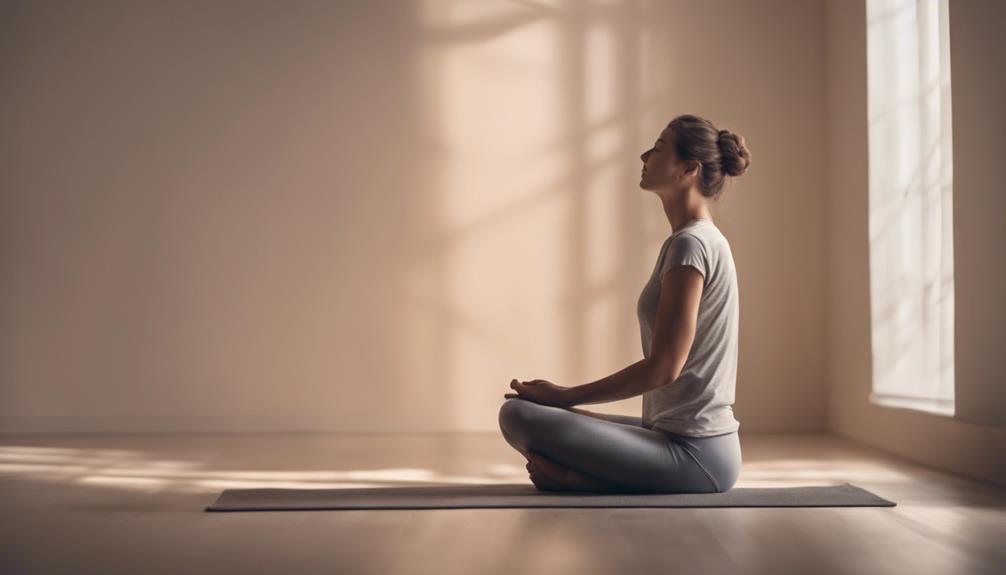Embark on your self-hypnosis journey with seven simple techniques: start with deep breathing for relaxation, visualize positive changes for transformative outcomes, practice progressive muscle relaxation to release tension, use affirmations to boost confidence, try guided imagery for stress relief, create a safe mental space, and explore self-hypnosis scripts for heightened focus. Mastering these techniques can lead to profound relaxation, enhanced focus, and personal development. Enhance your well-being with these beginner-friendly practices.
Deep Breathing for Relaxation

For beginners looking to explore self-hypnosis techniques, incorporating deep breathing for relaxation is a fundamental practice that can enhance focus and induce a state of calmness. Mindful breathing is a powerful tool that allows individuals to connect with their breath, bringing their attention to the present moment and fostering a sense of inner peace. By focusing on the inhalation and exhalation, practitioners can activate the body's relaxation response, triggering a cascade of physiological changes that promote relaxation and reduce stress.
To practice deep breathing for relaxation, find a comfortable and quiet space where you can sit or lie down. Close your eyes and take a slow, deep breath in through your nose, allowing your lungs to fill with air. Hold the breath for a few moments, then exhale slowly through your mouth, letting go of any tension or tightness in your body. Repeat this process several times, allowing each breath to deepen your sense of relaxation and calm.
Incorporating mindful breathing into your self-hypnosis practice can help you achieve a deeper state of relaxation, making it easier to enter a hypnotic trance and work towards your personal goals. By mastering this simple yet powerful technique, you can enhance your focus, reduce anxiety, and cultivate a greater sense of well-being.
Visualization for Positive Change
Exploring the power of visualization can be a transformative practice for individuals seeking positive change within their self-hypnosis journey. Visualization involves creating mental images of desired outcomes, engaging the mind-body connection to manifest goals.
When incorporating visualization into self-hypnosis, it is essential to start by setting clear and specific goals. Whether aiming for improved confidence, better health, or increased motivation, defining these objectives helps focus the mind and enhance the effectiveness of the practice.
Through visualization, individuals can mentally rehearse achieving their goals, picturing themselves succeeding in their endeavors. This process not only boosts motivation but also strengthens the belief in one's capabilities, paving the way for actualizing aspirations.
Progressive Muscle Relaxation

Utilizing progressive muscle relaxation can be a valuable technique for beginners embarking on their self-hypnosis journey. This method involves systematically tensing and then relaxing different muscle groups in the body, aiming to induce a deep state of relaxation.
By focusing on each muscle group, individuals can become more aware of tension areas and learn to release them, promoting a relaxation response throughout the body.
Progressive muscle relaxation is effective in reducing physical tension, which often accompanies stress and anxiety. As beginners practice this technique, they become more attuned to the sensations of tension release and relaxation within their bodies.
This heightened awareness can enhance their overall self-hypnosis experience by deepening relaxation and increasing mindfulness.
Through regular practice of progressive muscle relaxation, beginners can develop a greater sense of control over their body's responses to stressors, leading to improved physical and mental well-being.
This technique serves as a foundation for mastering self-hypnosis, providing a solid grounding in relaxation and tension release.
Affirmations for Self-Improvement
Beginners in self-hypnosis can significantly enhance their practice by incorporating affirmations for self-improvement into their routines. Daily affirmations are powerful tools that can boost confidence and self-esteem. By repeating positive statements such as 'I am capable and deserving of success,' individuals can reprogram their subconscious minds to believe in their abilities.
Self-love mantras play a crucial role in cultivating positivity and fostering a healthy self-image. Phrases like 'I am worthy of love and respect' can help individuals develop a deeper sense of self-acceptance and appreciation. These affirmations can counteract negative self-talk and instill a more optimistic outlook on life.
When integrating affirmations into self-hypnosis sessions, beginners should choose statements that resonate with them personally and align with their goals for self-improvement. Consistency is key, so practicing these affirmations regularly, preferably daily, can lead to profound changes in mindset and behavior.
Guided Imagery for Stress Relief

Incorporating guided imagery into your self-hypnosis practice can be a powerful tool for relieving stress and promoting relaxation. Guided imagery involves using your imagination to create calming and peaceful mental images, helping to shift your focus away from stressors and towards a more tranquil state of mind.
This technique can be particularly effective when combined with mindfulness meditation, as it encourages a heightened awareness of the present moment and can enhance the overall relaxation response in the body.
When practicing guided imagery for stress relief, find a quiet and comfortable space where you won't be disturbed. Close your eyes, take deep breaths, and envision a serene setting that brings you a sense of peace. Whether it's picturing a tranquil beach, a lush forest, or a cozy fireplace, allow yourself to fully immerse in the details of this mental oasis.
Creating a Safe Mental Space
Establishing a safe mental space is crucial for enhancing the effectiveness of your self-hypnosis practice. To create a safe mental space, incorporating mindfulness practice is key. Mindfulness involves being fully present in the moment, acknowledging thoughts and feelings without judgment. This practice helps in grounding yourself and fostering a sense of security during self-hypnosis sessions.
Emotional regulation is another vital aspect of creating a safe mental space. Before delving into self-hypnosis, take a moment to check in with your emotions. Acknowledge any feelings of anxiety, stress, or tension, and work on regulating them through deep breathing or visualization techniques.
Self-Hypnosis Scripts for Focus

Enhancing your focus through self-hypnosis scripts can significantly improve your ability to concentrate and achieve your goals efficiently. Concentration exercises are key components of self-hypnosis scripts for focus. These scripts often guide you through visualizations that help direct your attention to specific tasks or goals. By regularly practicing these scripts, you can train your mind to stay focused for longer periods.
Incorporating mindfulness techniques into self-hypnosis scripts can further enhance your ability to concentrate. Mindfulness encourages you to stay present in the moment, reducing distractions and improving your focus on the task at hand. Self-hypnosis scripts that include mindfulness techniques often involve deep breathing exercises and body scans to help you center your attention.
Frequently Asked Questions
Can Self-Hypnosis Be Dangerous or Harmful?
While self-hypnosis can offer various benefits, such as stress relief and behavioral change, it also carries potential risks. Negative effects may include false memories, emotional distress, or exacerbation of underlying mental health issues. It's crucial to approach self-hypnosis with caution.
How Long Does It Take to See Results From Self-Hypnosis?
Results from self-hypnosis can vary. Immediate effects may be noticed after a few sessions, focusing on relaxation or stress relief. Consistency in self-hypnosis practice is key for long-term benefits such as habit changes or increased confidence.
Can Self-Hypnosis Help With Physical Pain Relief?
Self-hypnosis can be a beneficial tool for physical pain relief by fostering mental wellbeing and stress management. Through focused relaxation techniques and positive suggestions, individuals may experience reduced pain perception and improved overall comfort.
Is Self-Hypnosis Effective for Everyone?
Self-hypnosis effectiveness varies due to individual differences. Success rates depend on factors like suggestibility and commitment. Proper guidance enhances outcomes, yet potential obstacles such as distractions or skepticism can hinder progress. Tailoring approaches to suit individuals maximizes benefits.
Can Self-Hypnosis Be Used to Overcome Phobias?
Self-hypnosis can be a valuable tool in managing fears and overcoming phobias. By employing coping strategies such as relaxation techniques and visualization, individuals can harness the power of their minds to address and conquer their deepest anxieties.
Conclusion
In conclusion, self-hypnosis can be a powerful tool for personal growth and relaxation. By practicing techniques such as deep breathing, visualization, and affirmations, individuals can tap into their subconscious mind to make positive changes in their lives.
Whether seeking stress relief, focus, or self-improvement, these simple self-hypnosis techniques can be easily incorporated into daily routines for lasting benefits. Take the time to explore these methods and discover the transformative power of self-hypnosis.
